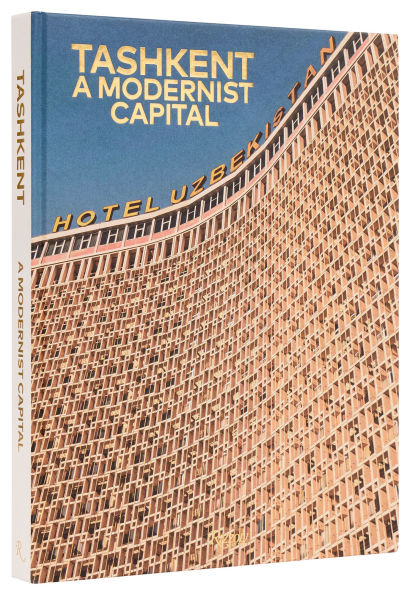Tashkent: A Modernist Capital
A shrine to Soviet modernist architecture, Tashkent is a rare jewel of modernism rediscovered in this book.
Established sometime around the 1st or 2nd century BCE, Tashkent is the capital city of Uzbekistan and the largest metropolis in Central Asia benefiting from its historical role as geographic crossroads, its developed resources, and its thriving multiculturalism. Previous Soviet rule was established in 1917—which over six decades heralded transformations in Tashkent’s culture, identity, and, of course, its landscape and architecture.
In this extraordinary volume, realized in collaboration with the Uzbekistan Art and Culture Development Foundation, photographer Karel Balas reveals the modernist architecture of Tashkent through a collection of never-before-seen photographs. Constructed between the 1960s and early ’90s, these buildings stand as powerful metaphors vis-à-vis Tashkent’s past and present, painting a picture of its rich cultural heritage. Part of the overlooked Soviet modernism movement, the expression of this new architectural style represents a vision and social function for the city as a whole—all the while connoting the specific character and modernization of Central Asia. Whether a 1964 cinema, the State Museum of the Arts, the 1970 Lenin Museum, or the striking Hotel Uzbekistan dated 1976, each structure tells a captivating story about one of the most enthralling cities on the Asian continent.
1145065962
Established sometime around the 1st or 2nd century BCE, Tashkent is the capital city of Uzbekistan and the largest metropolis in Central Asia benefiting from its historical role as geographic crossroads, its developed resources, and its thriving multiculturalism. Previous Soviet rule was established in 1917—which over six decades heralded transformations in Tashkent’s culture, identity, and, of course, its landscape and architecture.
In this extraordinary volume, realized in collaboration with the Uzbekistan Art and Culture Development Foundation, photographer Karel Balas reveals the modernist architecture of Tashkent through a collection of never-before-seen photographs. Constructed between the 1960s and early ’90s, these buildings stand as powerful metaphors vis-à-vis Tashkent’s past and present, painting a picture of its rich cultural heritage. Part of the overlooked Soviet modernism movement, the expression of this new architectural style represents a vision and social function for the city as a whole—all the while connoting the specific character and modernization of Central Asia. Whether a 1964 cinema, the State Museum of the Arts, the 1970 Lenin Museum, or the striking Hotel Uzbekistan dated 1976, each structure tells a captivating story about one of the most enthralling cities on the Asian continent.
Tashkent: A Modernist Capital
A shrine to Soviet modernist architecture, Tashkent is a rare jewel of modernism rediscovered in this book.
Established sometime around the 1st or 2nd century BCE, Tashkent is the capital city of Uzbekistan and the largest metropolis in Central Asia benefiting from its historical role as geographic crossroads, its developed resources, and its thriving multiculturalism. Previous Soviet rule was established in 1917—which over six decades heralded transformations in Tashkent’s culture, identity, and, of course, its landscape and architecture.
In this extraordinary volume, realized in collaboration with the Uzbekistan Art and Culture Development Foundation, photographer Karel Balas reveals the modernist architecture of Tashkent through a collection of never-before-seen photographs. Constructed between the 1960s and early ’90s, these buildings stand as powerful metaphors vis-à-vis Tashkent’s past and present, painting a picture of its rich cultural heritage. Part of the overlooked Soviet modernism movement, the expression of this new architectural style represents a vision and social function for the city as a whole—all the while connoting the specific character and modernization of Central Asia. Whether a 1964 cinema, the State Museum of the Arts, the 1970 Lenin Museum, or the striking Hotel Uzbekistan dated 1976, each structure tells a captivating story about one of the most enthralling cities on the Asian continent.
Established sometime around the 1st or 2nd century BCE, Tashkent is the capital city of Uzbekistan and the largest metropolis in Central Asia benefiting from its historical role as geographic crossroads, its developed resources, and its thriving multiculturalism. Previous Soviet rule was established in 1917—which over six decades heralded transformations in Tashkent’s culture, identity, and, of course, its landscape and architecture.
In this extraordinary volume, realized in collaboration with the Uzbekistan Art and Culture Development Foundation, photographer Karel Balas reveals the modernist architecture of Tashkent through a collection of never-before-seen photographs. Constructed between the 1960s and early ’90s, these buildings stand as powerful metaphors vis-à-vis Tashkent’s past and present, painting a picture of its rich cultural heritage. Part of the overlooked Soviet modernism movement, the expression of this new architectural style represents a vision and social function for the city as a whole—all the while connoting the specific character and modernization of Central Asia. Whether a 1964 cinema, the State Museum of the Arts, the 1970 Lenin Museum, or the striking Hotel Uzbekistan dated 1976, each structure tells a captivating story about one of the most enthralling cities on the Asian continent.
85.0
In Stock
5
1

Tashkent: A Modernist Capital
240
Tashkent: A Modernist Capital
240Hardcover
$85.00
85.0
In Stock

Product Details
| ISBN-13: | 9780847899982 |
|---|---|
| Publisher: | Rizzoli |
| Publication date: | 11/12/2024 |
| Pages: | 240 |
| Product dimensions: | 1.06(w) x 14.15(h) x 1.21(d) |
About the Author
From the B&N Reads Blog
